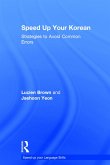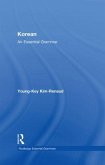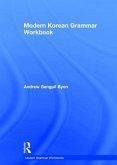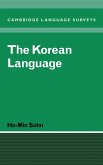The Routledge Handbook of Korean as a Second Language
Herausgeber: Byon, Andrew Sangpil; Pyun, Danielle Ooyoung
The Routledge Handbook of Korean as a Second Language
Herausgeber: Byon, Andrew Sangpil; Pyun, Danielle Ooyoung
- Broschiertes Buch
- Merkliste
- Auf die Merkliste
- Bewerten Bewerten
- Teilen
- Produkt teilen
- Produkterinnerung
- Produkterinnerung
The Routledge Handbook of Korean as a Second Language aims to define the field, and to present latest research in Korean as a Second Language (KSL).
Andere Kunden interessierten sich auch für
![Speed up your Korean Speed up your Korean]() Lucien BrownSpeed up your Korean184,99 €
Lucien BrownSpeed up your Korean184,99 €![Korean Korean]() Young-Key Kim-RenaudKorean183,99 €
Young-Key Kim-RenaudKorean183,99 €![Innovative Methods in Korean Language Teaching Innovative Methods in Korean Language Teaching]() Innovative Methods in Korean Language Teaching172,99 €
Innovative Methods in Korean Language Teaching172,99 €![Korean Conversation Gambits: Developing Spoken Language Korean Conversation Gambits: Developing Spoken Language]() Heekyung AhnKorean Conversation Gambits: Developing Spoken Language173,99 €
Heekyung AhnKorean Conversation Gambits: Developing Spoken Language173,99 €![Modern Korean Grammar Workbook Modern Korean Grammar Workbook]() Andrew ByonModern Korean Grammar Workbook183,99 €
Andrew ByonModern Korean Grammar Workbook183,99 €![An Introduction to the Korean Spoken Language An Introduction to the Korean Spoken Language]() Horace Grant UnderwoodAn Introduction to the Korean Spoken Language38,99 €
Horace Grant UnderwoodAn Introduction to the Korean Spoken Language38,99 €![The Korean Language The Korean Language]() Ho-Min SohnThe Korean Language152,99 €
Ho-Min SohnThe Korean Language152,99 €-
-
-
The Routledge Handbook of Korean as a Second Language aims to define the field, and to present latest research in Korean as a Second Language (KSL).
Produktdetails
- Produktdetails
- Verlag: Taylor & Francis Ltd (Sales)
- Seitenzahl: 572
- Erscheinungstermin: 4. Oktober 2024
- Englisch
- Abmessung: 246mm x 174mm x 30mm
- Gewicht: 948g
- ISBN-13: 9781032219059
- ISBN-10: 103221905X
- Artikelnr.: 71713265
- Herstellerkennzeichnung
- Libri GmbH
- Europaallee 1
- 36244 Bad Hersfeld
- gpsr@libri.de
- Verlag: Taylor & Francis Ltd (Sales)
- Seitenzahl: 572
- Erscheinungstermin: 4. Oktober 2024
- Englisch
- Abmessung: 246mm x 174mm x 30mm
- Gewicht: 948g
- ISBN-13: 9781032219059
- ISBN-10: 103221905X
- Artikelnr.: 71713265
- Herstellerkennzeichnung
- Libri GmbH
- Europaallee 1
- 36244 Bad Hersfeld
- gpsr@libri.de
Andrew Sangpil Byon is Associate Professor in the Department of East Asian Studies at the University at Albany, State University of New York. Danielle Ooyoung Pyun is Associate Professor in the Department of East Asian Languages and Literatures at The Ohio State University, Columbus, Ohio.
1 Korean as a Second/Foreign Language (KSL): An overview
PART I: The acquisition of Korean as a second language
2 Second Language Learning of Polysemous Korean Words
3 Phonological Acquisition
4 Linguistic Politeness
5 KSL Syntax and Semantics
6 Relative Clauses in Korean as a Second Language: Old and New Findings
PART II: Teaching and learning Korean as a second language
7 Pragmatic Teaching and Learning
8 Task-Based Language Teaching in Korean Classroom Contexts: Promoting Learner Engagement during Task Performance
9 Instructional Technology in KSL Settings
10 Culture in Korean Language Teaching: Focusing on a Dynamic View of Culture
11 Korean for Specific Purposes
12 Content-Based Instruction in KSL Settings
13 Community Service-Learning in Korean
PART III: Approaches to Korean as a second language
14 Corpus-Based Research and KSL
15 Conversation Analysis for KSL: Teaching and Learning Sequence Organization
16 The Intersection of Discourse, Grammar, Register, Pragmatics, and Culture
17 Error Analysis
18 Social Interactions in KSL settings
19 National Standards and Korean as a Second Language
20 Usage-Based Approach to Grammar in Korean Language Teaching and Learning
PART IV: Individual differences and social factors
21 Individual Learner Differences in Learning Korean as a Second Language
22 Korean as a Heritage Language
23 Language Ideologies and Identity Formation among KSL Learners
24 Instructor Individual Characteristics in a KSL/KFL Setting: A Research Perspective
PART V: Assessment
25 KSL Assessment: The TOPIK, Achievement Tests, and Research Trends
26 Integrated Performance Assessment and KSL
27 Interactional Competence in Korean and its Assessment
PART I: The acquisition of Korean as a second language
2 Second Language Learning of Polysemous Korean Words
3 Phonological Acquisition
4 Linguistic Politeness
5 KSL Syntax and Semantics
6 Relative Clauses in Korean as a Second Language: Old and New Findings
PART II: Teaching and learning Korean as a second language
7 Pragmatic Teaching and Learning
8 Task-Based Language Teaching in Korean Classroom Contexts: Promoting Learner Engagement during Task Performance
9 Instructional Technology in KSL Settings
10 Culture in Korean Language Teaching: Focusing on a Dynamic View of Culture
11 Korean for Specific Purposes
12 Content-Based Instruction in KSL Settings
13 Community Service-Learning in Korean
PART III: Approaches to Korean as a second language
14 Corpus-Based Research and KSL
15 Conversation Analysis for KSL: Teaching and Learning Sequence Organization
16 The Intersection of Discourse, Grammar, Register, Pragmatics, and Culture
17 Error Analysis
18 Social Interactions in KSL settings
19 National Standards and Korean as a Second Language
20 Usage-Based Approach to Grammar in Korean Language Teaching and Learning
PART IV: Individual differences and social factors
21 Individual Learner Differences in Learning Korean as a Second Language
22 Korean as a Heritage Language
23 Language Ideologies and Identity Formation among KSL Learners
24 Instructor Individual Characteristics in a KSL/KFL Setting: A Research Perspective
PART V: Assessment
25 KSL Assessment: The TOPIK, Achievement Tests, and Research Trends
26 Integrated Performance Assessment and KSL
27 Interactional Competence in Korean and its Assessment
1 Korean as a Second/Foreign Language (KSL): An overview
PART I: The acquisition of Korean as a second language
2 Second Language Learning of Polysemous Korean Words
3 Phonological Acquisition
4 Linguistic Politeness
5 KSL Syntax and Semantics
6 Relative Clauses in Korean as a Second Language: Old and New Findings
PART II: Teaching and learning Korean as a second language
7 Pragmatic Teaching and Learning
8 Task-Based Language Teaching in Korean Classroom Contexts: Promoting Learner Engagement during Task Performance
9 Instructional Technology in KSL Settings
10 Culture in Korean Language Teaching: Focusing on a Dynamic View of Culture
11 Korean for Specific Purposes
12 Content-Based Instruction in KSL Settings
13 Community Service-Learning in Korean
PART III: Approaches to Korean as a second language
14 Corpus-Based Research and KSL
15 Conversation Analysis for KSL: Teaching and Learning Sequence Organization
16 The Intersection of Discourse, Grammar, Register, Pragmatics, and Culture
17 Error Analysis
18 Social Interactions in KSL settings
19 National Standards and Korean as a Second Language
20 Usage-Based Approach to Grammar in Korean Language Teaching and Learning
PART IV: Individual differences and social factors
21 Individual Learner Differences in Learning Korean as a Second Language
22 Korean as a Heritage Language
23 Language Ideologies and Identity Formation among KSL Learners
24 Instructor Individual Characteristics in a KSL/KFL Setting: A Research Perspective
PART V: Assessment
25 KSL Assessment: The TOPIK, Achievement Tests, and Research Trends
26 Integrated Performance Assessment and KSL
27 Interactional Competence in Korean and its Assessment
PART I: The acquisition of Korean as a second language
2 Second Language Learning of Polysemous Korean Words
3 Phonological Acquisition
4 Linguistic Politeness
5 KSL Syntax and Semantics
6 Relative Clauses in Korean as a Second Language: Old and New Findings
PART II: Teaching and learning Korean as a second language
7 Pragmatic Teaching and Learning
8 Task-Based Language Teaching in Korean Classroom Contexts: Promoting Learner Engagement during Task Performance
9 Instructional Technology in KSL Settings
10 Culture in Korean Language Teaching: Focusing on a Dynamic View of Culture
11 Korean for Specific Purposes
12 Content-Based Instruction in KSL Settings
13 Community Service-Learning in Korean
PART III: Approaches to Korean as a second language
14 Corpus-Based Research and KSL
15 Conversation Analysis for KSL: Teaching and Learning Sequence Organization
16 The Intersection of Discourse, Grammar, Register, Pragmatics, and Culture
17 Error Analysis
18 Social Interactions in KSL settings
19 National Standards and Korean as a Second Language
20 Usage-Based Approach to Grammar in Korean Language Teaching and Learning
PART IV: Individual differences and social factors
21 Individual Learner Differences in Learning Korean as a Second Language
22 Korean as a Heritage Language
23 Language Ideologies and Identity Formation among KSL Learners
24 Instructor Individual Characteristics in a KSL/KFL Setting: A Research Perspective
PART V: Assessment
25 KSL Assessment: The TOPIK, Achievement Tests, and Research Trends
26 Integrated Performance Assessment and KSL
27 Interactional Competence in Korean and its Assessment



